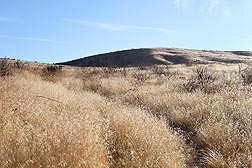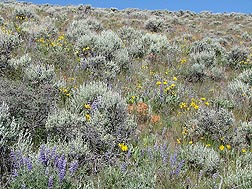Step-by-Step Strategies for Restoring Western Rangelands
|
|
Invasive plants exploit every environmental angle in their favor. So restoring damaged rangelands in the western United States involves a lot more than just getting rid of bad plants and bringing in good plants.
Since 1990, Agricultural Research Service ecologist Roger Sheley has been refining a process for identifying factors that give the undesirable space invaders their territorial edge—and figuring out strategies for restoring a healthy mix of native vegetation for rangelands in need of remediation.
“Killing a weed is like treating a symptom,” says Sheley, who is co-located at Oregon State University’s Eastern Oregon Agricultural Research Center in Burns, Oregon. “So our research has been focused on trying to understand the reason why plants are able to invade and dominate some landscapes and not able to succeed in others. We want to find the cause and then deal with the cause—what has changed in the ecology of the system and how can we change it back?”
Sheley used a range of findings in the literature and years of field research at Burns to develop a decision-making model called “Ecologically Based Invasive-Plant Management” (EBIPM). The process is a mix of longstanding theories of plant establishment and succession, new ecological principles, identification of variables that contribute to invasive plant management, and actions that can help native plants regain territory lost to invasive vegetation.
|
|
Using EBIPM, Sheley was able to increase the chance of restoration success by 66 percent over traditional approaches to invasive weed management. That could be a boon to land managers in the western rangelands, where invasive plants like cheatgrass are fueling wildfires and limiting livestock grazing options.
“Another term for our work is ‘augmentative restoration,”’ Sheley says. “In rangeland restoration, not everything needs to be done everywhere. It’s much more effective to change restoration procedures based on what we observe as we move across the landscape.”
Plant Succession—Not So Simple
Ecologists have often assumed that plant communities almost always follow a succession trajectory mainly determined by climate and unpredictably affected by management activities. For instance, a site would initially be colonized by mosses and lichens, which would help create conditions favorable for the growth of forbs, grasses, and shrubs.
Sheley and his colleagues based their work on another approach that proposed three general causes of plant succession: site availability, species availability, and species performance. This model held that site-specific ecological processes strongly influence plant succession dynamics and that these processes in turn are modified by natural and management-imposed factors that affect plant establishment and long-term vegetation change. Once these factors have been identified, successional management decisions can be used to coordinate activities that fine-tune the mechanisms and processes influencing plant succession—all of which helps rout invasive plants and restore native grasses and forbs.
|
|
Sheley and his colleagues tested their model in Montana’s Kicking Horse Wildlife Mitigation Area at three sites that had varying degrees and types of damage from invasive plants. The first site had been overrun with spotted knapweed, sulphur cinquefoil, and cheatgrass. In addition, meadow voles had disturbed the soil by digging numerous tunnels, which increased the amount of bare ground ripe for infestation.
The second site didn’t have meadow voles or a lot of bare ground, and it did have a substantial native plant population that could help support restoration. But the native plants were already competing with the invasive plants that had moved in.
The third site was wetter, which provided good condition for the establishment of desirable plants. But it didn’t have a significant native plant population that could help jump-start restoration.
One Step at a Time
The first step in the EBIPM process was to assess each site using the Rangeland Health Assessment protocol, a system already used by many federal land managers for evaluating rangeland conditions, and identify the ecological processes that needed to be repaired. For instance, at the first site, the team decided that the major succession dynamic facilitating invasive success was “site availability.” This was the result of several factors—including bare ground, soil surface loss, dry soils, and the lack of a native plant population—all of which also blocked the development of a healthy native plant community.
But at the second site, the team determined that “species performance” was the successional process dominating plant establishment and survival, since the native plants at the site were outnumbered by their invasive neighbors. So at this site, management activity needed to promote the success of the native plants over the invasive vegetation.
At the third site, native plant populations were low, which had given invasive plants the opportunity to become established. The researchers decided that both “species availability” and “site availability” were the successional issues that needed to be addressed.
Then the team developed strategies that targeted the ecological processes contributing to the successional dynamics at each site. At the first site, they seeded the bare sites with a mix of native plant species and watered them. At the second site they killed the invasive species with herbicides and disked the soil, both of which opened up space for the existing native plants to expand their range. They also lightly disked parts of the third site and then seeded it with a mix of native plants. This site was next to a wetland, so there was sufficient water available to support the emergence and growth of seedlings.
Sheley and his partners found that seeding and watering at the first site produced the highest native grass and forb density, while at the third site, tillage was key to the establishment and survival of native grasses and forbs. Using herbicides at the second site did not appear to have any significant benefits for the establishment and survival of the native plants.
Still, Sheley thinks that two out of three is a noteworthy success rate for EBIPM.
“When we pick and choose how to support site-specific succession processes by repairing or replacing those processes, we can significantly enhance traditional successional restoration,” Sheley says. “It can save land managers time and money, and it also helps lower the risk of unintentionally harming the ecosystem processes when we decide to intervene. This system allows us to integrate what we’re actually seeing—what works, and what doesn’t work—in sustainable invasive-plant management and restoration programs to create predictable and valuable vegetation changes.”—By Ann Perry, Agricultural Research Service Information Staff.
This research is part of Crop Protection and Quarantine, an ARS national program (#304) described at www.nps.ars.usda.gov.
Roger Sheley is in the USDA-ARS Range and Meadow Forage Management Research Unit, 67826-A Hwy. 205, Burns, OR 97720; (541) 573-8938.
"Step-by-Step Strategies for Restoring Western Rangelands" was published in the February 2012 issue of Agricultural Research magazine.









